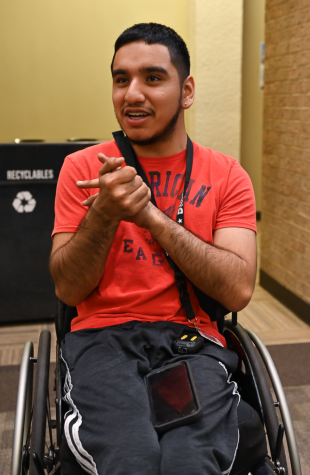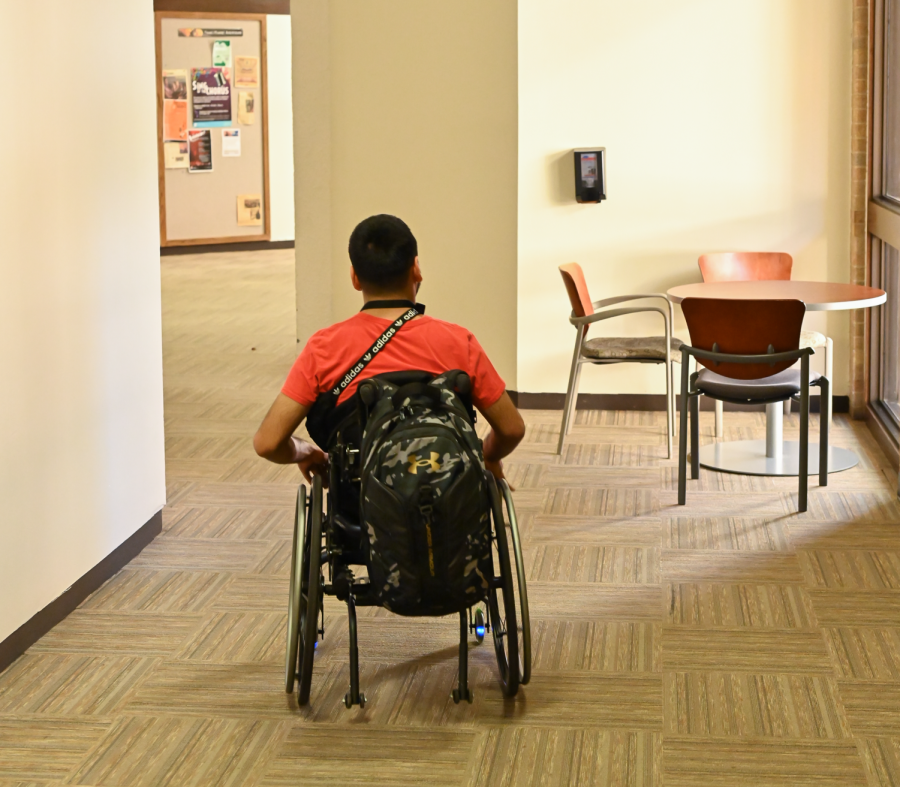Student learns to navigate campus obstacles
Jose Cardoso moves through the hallway of the F building at Eastfield.
December 6, 2022
Every Tuesday and Thursday, business major Jose Cardoso is dropped off in front of the F Building at Eastfield. It’s his first semester of college and all his classes are in that same building, so he’s still figuring out which entrance is the easiest for him to navigate on his own.
Cardoso makes his way slowly up the wheelchair-accessible ramp but struggles to keep the momentum in his manually powered chair because of the steep incline. Taking his time, he finally makes it to the door and into his 9:30 a.m. class.
Luckily, he wasn’t running late this morning.
“I just have a hard time getting up with my wheels,” he said. “I almost fell [today], but thankfully I had enough muscle to overpower it.”
The F Building entrance isn’t the only challenge for students with mobility challenges. Currently, one-third of the elevators on the Eastfield are missing at least one railing, and only two elevators are compliant with the Americans with Disabilities Act size requirements. The N Building doesn’t have an elevator at all.

Jose Cardoso moves through the hallway of the F building at Eastfield. (RORY MOORE/THE ET CETERA)
To be ADA compliant, an elevator must be a minimum of 68 inches wide and 51 inches deep. The elevators on campus range in size from 72 inches by 45 inches down to 55 inches by 35 inches, according to measurements taken by the Et Cetera.
Facilities manager Adam Qualkenbush said his department is aware of the missing elevator handrails and tries to fix them promptly.
“We replace those as they come off,” Qualkenbush said. “Unfortunately, some students are a little rough with them and seem to like to take them down on a regular basis. So that’s a continuing battle that we fight.”
Over half of the ADA automatic door buttons on campus also do not work properly or will only open from either the inside or outside of the building. Neither automatic door is currently functional in the G Building, which would require any student in a wheelchair to ask for assistance to enter the building.
“The buttons might be out of batteries or there might be a malfunction in the opener,” Qualkenbush said. “Our doors are constantly having issues one way or another, whether they’re accessible or not.”
Cardoso has been in a wheelchair his entire life. He has navigated inconvenient ramps and elevators for as long as he can remember. While the Eastfield campus is far from the least wheelchair accessible space he’s been in, he said there are some changes that would help students with mobility issues.
The Accessibility Services Office helps students when these things happen. If they are aware of an issue on campus that is affecting mobility for students with disabilities, they make sure to escalate it to facilities immediately so it can be taken care of.
“If there’s a student upstairs that can’t get downstairs because the ADA elevator is out, we would alert facilities and possibly campus police to see if they can get them down,” said Robin DuLaney-Heerdt, coordinator of Accessibility Services.
Chancellor Justin Lonon said he had not been made aware of the accessibility issues on campus.
“Certainly anything that is around the ADA compliance, there is a specific defined timeline where we are required to make sure that we’re paying attention to that technology and addressing any repairs that need to be addressed,” Lonon said. “Clearly, we have commitment to our disabled students and community members.”
Since 1990, the ADA has prohibited discrimination against individuals with disabilities in all areas of public life, including institutions of higher learning. Dallas College must adhere to the ADA to provide its students with accommodations they need to learn at the same level as everyone else.
“We are overseen by the Department of Education and the Department of Justice, through the Office of Civil Rights,” Dean of Accessibility Services Beverly Neu Menassa said. “They monitor institutions of higher education to make sure that we’re doing what we need to be doing for our students. And if we’re not, there can be pretty severe consequences.”
Despite some obstacles, Cardoso knows how to navigate inside the campus easily. He’s found the quickest ways to get from class to class and into the Hive to meet his friends. “I’m pretty good at moving with my chair,” he said. “For other kids that have a disability, like a wheelchair, it could be a lot more difficult than it is for me because I’m more experienced.”
Cardoso uses a standard size manual wheelchair that holds his legs out at a slight angle. To fit into one of the smaller elevators in the C building, he positions himself with his feet pushed into the corner and the back of his chair facing the elevator door. Without handrails to help him make small adjustments to his positioning, it requires a lot of small movements back and forth with his wheels to fit in.

“I’ve not personally been involved with a student who’s in a wheelchair that is too large to get into one of the smaller elevators,” DuLaney-Heerdt said. “You can do it, and I have done it personally with some students. It’s a tight squeeze, but as long as they’re not panicked, and you can get in the elevator and maneuver, we can certainly do that.”
According to the Dallas College website, during an emergency evacuation, elevators may not be available.
“People requiring physical assistance to evacuate the building should make their way, if possible, to the stairwell exit of any campus building,” the webpage reads.
From there, the person requiring assistance is to report to a College Emergency Response Team (CERT) member who will contact first responders to facilitate the evacuation.
“Any accessibility issue is handled as quickly as we can, but there is no timeline associated,” Qualkenbush said. “Depending on the problem, the severity of the problem or parts available, sometimes it’s five minutes to change out a battery, sometimes its four weeks to wait on a part.”
Some employees have suggested that staffing shortfalls could be contributing to the delays. However, these concerns were refuted when brought up to Lonon.
“There is a new ticketing system that facilities is utilizing, so if it’s not working and causing long gaps or delays, I want to make sure that we follow up on that,” Lonon said. “I’m not aware if there’s been facilities staffing concerns, but I’m hoping it’s just some process challenges that are going on.”
Cardoso says starting college was intimidating for him because he was leaving the comfort of high school. But he’s learning to enjoy some of the freedoms that come with adulthood and looking forward to experiencing more at Eastfield.
“I just wish the ramps outside made it easier to get in and out,” he said. “Instead of having to ask some- one to push me around, I want to do it myself. I want to be independent.”






